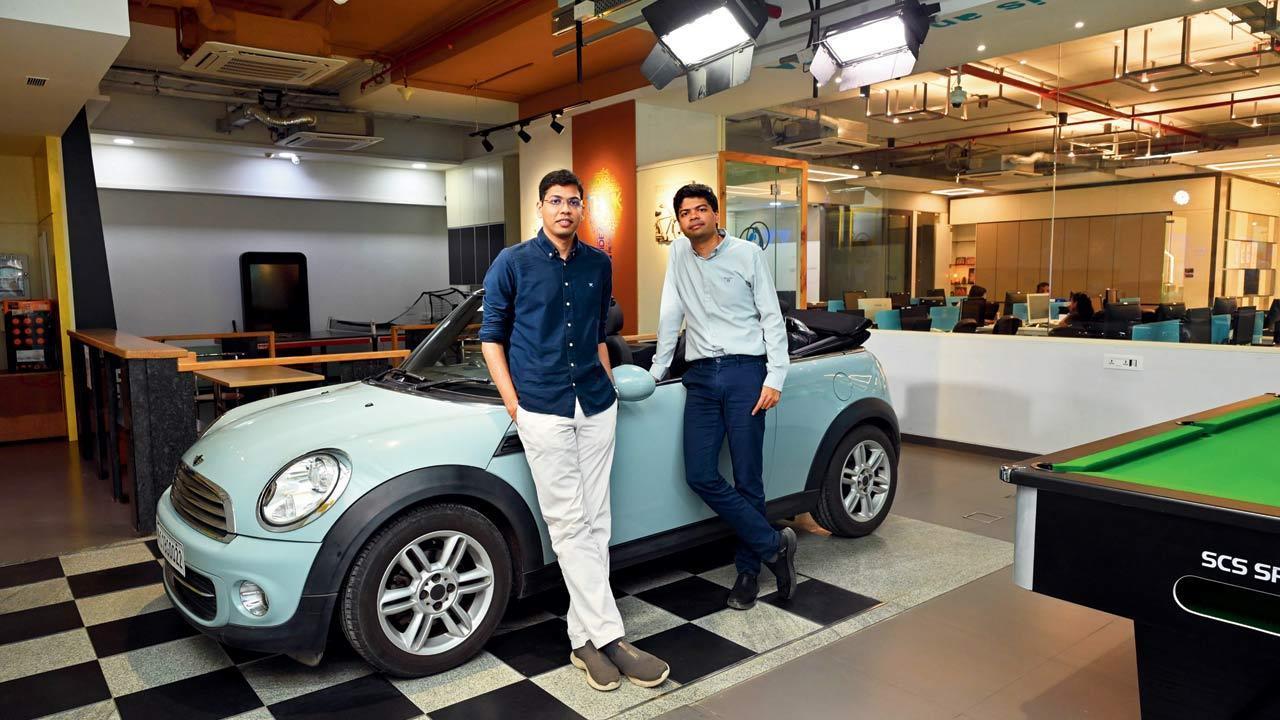Two brothers who launched India’s first AI-authored book look ahead to a future where artificial intelligence removes the technological divide in the world

Abhinav and Raghav Aggarwal’s Parel workspace is filled with cool gadgets and whimsy, like a Mini Cooper right in the centre of the office floor. It’s what the brothers use for their next project—developing assistive AI for cars. Pic/Atul Kamble
Brothers Abhinav, 33, and Raghav Aggarwal, 37, have been in the artificial intelligence game for over a decade now and have learned enough to write a book about it. Instead, they got AI to write it.
ADVERTISEMENT
Titled Bridging The AI Gap, this is the first AI-authored book to emerge from India. The Aggarwal brothers founded their firm Fluid AI in 2012 to provide businesses with artificial intelligence-driven solutions and analytics. Over the years, one of the questions most commonly posed by clients was how they can successfully deploy AI and get the most value out of it. “AI used to have a high failure rate about a couple of years ago. Seventy per cent of times, it would fail. But our organisation had a very low failure rate compared to the industry rate. So, we thought a book might help others learn how to get the most out of AI,” says Abhinav, co-founder and CEO the Prabhadevi firm.
Raghav, co-founder and managing director, adds, “We had built this intelligent technology and wanted to showcase its power too. That’s how it ended up as a book on how to successfully use AI, written by AI.”
Building and training the algorithm took the duo two months. Once it was ready, the AI took just a couple of hours to generate the book, they say.
And this is not a one-trick pony. “This algorithm will now form the basis for other things we do for our clients. It’s intelligent tech, it can do more than write a book. For example, it can create a sales deck in a matter of 30 seconds. You give it all the info about your products, you can tell it to generate a deck of products and the AI will do it instantly,” says Abhinav.
A lot of the work Fluid AI does is geared towards making work easier for employees, and streamlining processes. The firm has several major banks for clients, including Bank of America, as well as manufacturing plants. “One of the problems
we tackle is one that a lot of organisations face. They have a lot of processes and SOPs, but when you need to find out what a particular process is, no one knows where to find it. So, we create a GPT [generative pre-trained transformers] for them which ingests all the official documentation and SOPs and acts as an AI assistant which can answer your queries,” says Abhinav.
“This could translate to an AI assistant at a manufacturing plant which can tell you what to do when a machine breaks down or shows an error code. Or it can be an assistant at a call centre where it assists employees or even answers customers’ calls and sorts out their queries as well,” he adds.
‘AI won’t replace humans’
Will AI take over our jobs in the future then? Abhinav says that’s far from the truth. “AI is not meant to replace humans but just help them achieve more. Everyone assumes there is a finite amount of work, but this is the lump of labour fallacy. Just because machines can now do, say, 40 per cent of the work, doesn’t mean humans will only be needed for the remaining 60 per cent. Instead, work will just expand and the organisation can now achieve a lot more. The same thing happened in the industrial revolution and during the computer boom. Quality of service will go up and cost of operations will go down,” say the brothers, both of whom have a background in finance, with Raghav certified as a CA, and Abhinav as a CFA.
The next five to ten years will be the most exciting decade for mankind, say the brothers. “AI will remove the technological barrier that can sometimes put people at a disadvantage. Grandparents who struggle to use tech and have to ask their kids to help them will simply be able to ask AI for help. Someone from a rural area who may not have had a chance to learn English will be able to work with and communicate with anyone across the planet, speaking to them through AI, and the other person won’t even know it,” says Abhinav, adding that the next big step is introducing AI to robotics. “It’s already happening. In the future, you’ll be able to tell AI that you feel like eating pasta, and it’ll even make it for you,” he concludes.
What is the tech: A fully intelligent AI assistant that can help you do anything within your organisation.
How it works: Upload the organisation’s information within hours, and ask the AI any question about processes. You can even ask it to draft a sales pitch, or pull up a customer’s order details.
Whom does it help: AI will largely help employees be more productive and get more done.
 Subscribe today by clicking the link and stay updated with the latest news!" Click here!
Subscribe today by clicking the link and stay updated with the latest news!" Click here!







